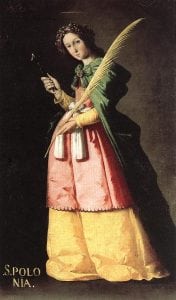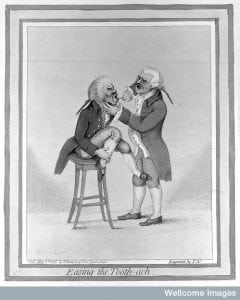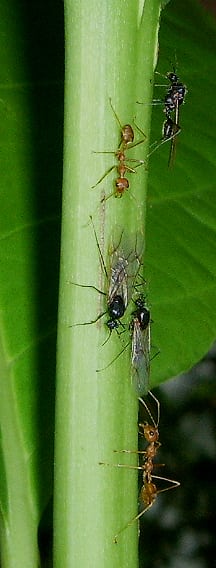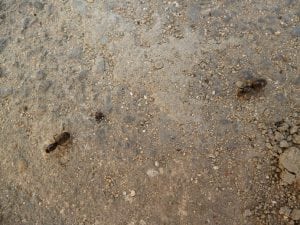By Chelsea Clark
Sloane was unique in his collecting habits and connections to gardens. He was passionate about obtaining plant specimens and discovering their various medical uses, however, appeared to be less interested in being personally involved in gardening. This is apparent when comparing his practices to those of his friend and colleague, Richard Richardson.
Despite the growing popularity of private gardens in England, Sloane did not have a garden of his own. His method of collecting botanical specimens was to dry them and press them in books, or keep them as seeds. Many of his letter correspondents cultivated gardens of their own and experimented with acclimatizing foreign specimens to English soil. Why did Sloane assist the Chelsea Garden at its time of crisis (mentioned in first post) if he was not trying to gain access to a garden of live specimens? How did his apparent abstinence from gardening connect with his support of the Chelsea Garden for the advancement of pubic botanical knowledge?
Sloane valued the plant knowledge that could be obtained from the garden knowing that it would indirectly aid him in his own pursuits as well as the greater scientific community. The published catalogue of the first transfer of fifty specimens (Philosophical Transactions, 1722) stated that Sloane’s motivation was to “encourage and promote an Undertaking so serviceable to the Publick.”
Curiously, there were no records of letter communication from Phillip Miller, the botanist placed in charge of the Chelsea Garden, to Sloane in regards to the Chelsea Garden. It seems most likely that the lack of correspondence reflects Sloane’s close proximity to the garden and opportunities to see Miller in person. (Though, arguably, it might also suggest that Sloane was disconnected from the garden.)
Richard Richardson, maintained a garden of his own at his home in North Bierley. His private garden earned a reputation as the best in North England and housed both native and foreign plants, including a hot house for growing exotic fruits. Richardson collected for his garden himself on explorations as well as obtained specimens through his associations with other private and public gardens. From his letters to Sloane, Richardson appears passionate about exotic specimens, whether it was acclimatizing them to English conditions or fabricating greenhouses to mimic their native growing conditions. This was a much different approach to specimens than Sloane’s.
Richardson mentioned his garden in North Bierley several times to Sloane. It contained botanicals that even the Apothecaries’ Chelsea Physic Garden lacked. Richardson obtained plants for his personal garden from public gardens, such as the Edinburgh Physic Garden. This exchange of plants between private and professional gardens is an interesting feature of English gardens.
These private collectors were also part of an exchange network with Dutch and French professional gardens. One reason was that the men who were collecting, like Richardson, had the wealth and leisure to maintain a garden and were associated with scientific societies like the Royal Society of London. Their collection of botanicals was not just for aesthetic reasons or to display their status, but their scientific functions gave collectors the authority and expertise to trade with the professional gardens of physicians and apothecaries.
In a letter to Sloane dated 13 November 1725, Richardson mentioned an “unfortunate accident” that occurred to some “scotch plants” from the Physic Garden at Edinburgh which he “proposed to have brought back … for my garden.” In addition to collecting from other gardens to fill his own, Richardson mentioned also wanting to make his collecting habits useful to others by collecting plants from northern England for the Chelsea Physic Garden and Mr. Miller. Unfortunately, he ran into some difficulties in creating such a relationship with Miller. On 8 April 1727, Richardson wrote about exchanging mosses with Miller for some seeds. On 19 November 1728, Richardson mentioned receiving a list of desired plants from Miller and had been collecting what was still in season from his garden to send to Chelsea.
Richardson’s attempt at a reciprocal relationship of exchange from his garden to the Chelsea public garden soon fell apart. By 16 March 1729, Richardson had stopped receiving letters from Miller. Even after a visit to Chelsea in the summer, during which Miller promised he would send Richardson a letter detailing which plants the garden was lacking, Richardson wrote to Sloane on 3 November 1729 that he had not received a letter of this sort. For some reason, unknown to Richardson, their amicable exchange ceased. (For more on relationship etiquette see this post regarding Abbe Bignon and Sloane).
Richardson sought out associations with other gardens, and he demonstrated great attachment to and took great care with his own garden. It is likely that Sloane received dried plant specimens or seeds from Richardson’s personal garden that had originally come from Miller at the Chelsea Garden, given that he was recieving other dried specimens from Richardson. Other than that, Sloane’s involvement in the Chelsea garden appears to have been kept separate from his desire to collect and classify, stemming instead from his desire to expand the public’s botanical knowledge and to ensure supplies of medical specimens.


















